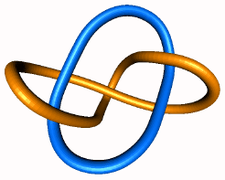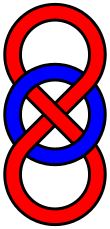Whitehead link
| Whitehead link | |
|---|---|
 | |
| Braid length | 5 |
| Braid no. | 3 |
| Crossing no. | 5 |
| Hyperbolic volume | 3.663862377 |
| Linking no. | 0 |
| Unknotting no. | 2 |
| A-B notation |
52 1 |
| Thistlethwaite | L5a1 |
| Last /Next | L4a1 / L6a1 |
| Other | |
| alternating | |

.jpg)
In knot theory, the Whitehead link, named for J. H. C. Whitehead, is one of the most basic links.
Whitehead spent much of the 1930s looking for a proof of the Poincaré conjecture. In 1934, the Whitehead link was used as part of his construction of the now-named Whitehead manifold, which refuted his previous purported proof of the conjecture.
Structure
The link is created with two projections of the unknot: one circular loop and one figure eight-shaped loop (i.e., a loop with a Reidemeister Type I move applied) intertwined such that they are inseparable and neither loses its form. Excluding the instance where the figure eight thread intersects itself, the Whitehead link has four crossings. Because each underhand crossing has a paired upperhand crossing, its linking number is 0. It is not isotopic to the unlink, but it is link homotopic to the unlink.
In braid theory notation, the link is written
Its Jones polynomial is
This polynomial and  are the two factors of the Jones polynomial of the L10a140 link. Notably,
are the two factors of the Jones polynomial of the L10a140 link. Notably,  is the Jones polynomial for the mirror image of a link having Jones polynomial
is the Jones polynomial for the mirror image of a link having Jones polynomial  .
.
See also
- Solomon's knot
- Weeks manifold
- Whitehead double
External links
| ||||||||||||||||||||||||||||||

